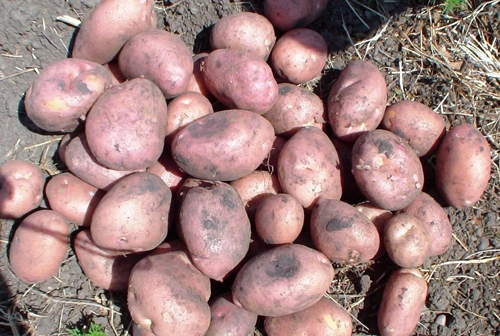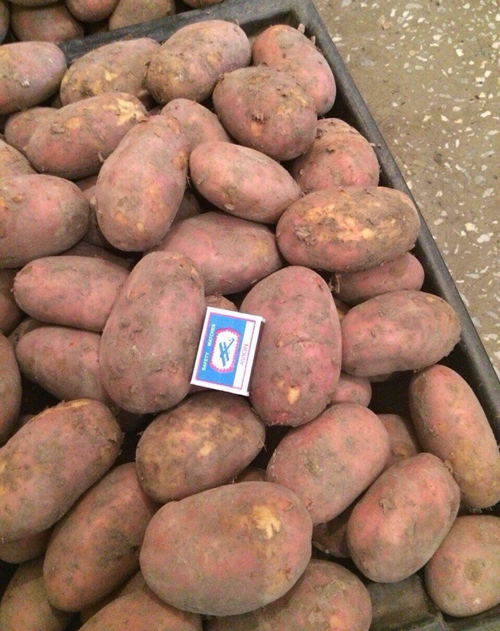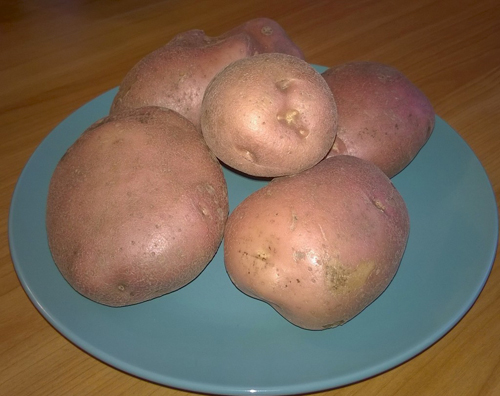Romano potato variety
Romano is a medium early potato variety (Solanum tuberosum) for table use. Bred by specialists of the Dutch company "Agrico U.A." Included in the state register of plants of the Russian Federation in 1994, approved for cultivation in five regions of the country: Central, Volgo-Vyatka, Central Chernozem, Ural, Far East. It can grow on any type of soil, in various climatic conditions. Suitable for mechanical cleaning, long distance transportation and long-term storage.

The time from the emergence of full shoots to ripening is 65-80 days.
The plant is tall, compact, not spreading. The main stem is erect. Leaves are medium in size, dark green in color. A slight waviness is observed along the edges of the sheet plate. Flowers of bright red-violet color, collected in corollas. The berries are small, few of them are formed.
In one nest, 8-13 large homogeneous tubers weighing 70-90 grams, oval or round-oval, are formed. The rind is very firm, pale pink in color, smooth to the touch. The pulp is dense, light cream in color. The eyes are small, in small numbers, the depth of occurrence is medium.
Romano's yield under the state test was 110-320 c / ha, and the maximum was recorded at 347 c / ha. Thus, it is possible to obtain about 1 kg of tubers from one plant. Marketability is high - 90−94%. In general, the beautiful appearance of tubers is considered one of the main advantages of the variety. At the same time, the dense skin protects the potatoes from mechanical damage during harvesting and transportation, so that they do not lose their presentation. Keeping quality is very good - 98%, the tendency to germination is low.

Romano is classified as culinary type B, which means medium digestion of the tubers. Taste qualities are excellent, evaluated by experts at 5 points out of 5 possible. Due to their dense pulp, tubers have a universal purpose and will become an excellent component of a wide variety of dishes. It is difficult even to give any recommendations for cooking, since these potatoes are good in any form! The dry matter content in the pulp is kept at 19.7%, and the starch content is 10-13%.
The variety is absolutely undemanding to the type of soil. Feels great on almost all types of soil, in a variety of climatic conditions. At the same time, the yield is always kept at a high level, the tubers grow of normal size, small ones are very rare. Of course, such results can be achieved only if certain agrotechnical rules are observed, the main of which are presented below.
- Planting is recommended to be done after the soil warms up to + 15−20 ° С. The seed can be cut, which is undoubtedly a huge plus.
- It can be grown both in the Dutch and in the standard way, while the yield will not differ much.
- Depending on the fertility of the soil, fertilizing should be carried out as needed during the growing season. In soils that are poor in nutrients and trace elements, it will be enough to apply fertilizers once or twice.

- Plants tolerate drought well, but do not completely forget about watering, especially in the southern regions with very hot summers. For such areas, it is recommended to water the plantings two or three times.
- It is also necessary to mention the basic elements of care: loosening the soil and hilling, weeding, pest and disease treatment. And don't forget about crop rotation! When potatoes are planted on the same plot, the risk of infection of plants with diseases characteristic of this crop increases several times in a row.
- Experts recommend mowing the tops a week before harvesting. After harvesting, the tubers should be well dried.
- A feature of the Romano variety is a slightly slower early development of tubers. Thus, when planting in mid-May, it is better to start digging no earlier than mid-August.
The species is highly resistant to cancer and blackleg, potato nematode, and viruses A and Y.Moderately resistant to leaf curling, rhizoctonia, susceptible to common scab. Tuber crops are moderately susceptible to late blight, tops are affected much less often. As for pests, the originator does not provide information about this. However, according to the observation of gardeners, with a single preventive treatment with insecticides, the Colorado potato beetle and wireworm bypass the plants.
Romano has earned the title of one of the best mid-early food varieties. It is especially appreciated for its excellent presentation of tubers, their uniformity and great taste. The list of advantages also includes high yield, versatility of use, good adaptation to any soil and climate, and drought resistance. The excellent keeping quality also deserves attention; with prolonged storage, tubers do not germinate for a long time. This potato is in great demand among large agricultural firms, as it is resistant to mechanical damage and retains its excellent appearance during machine harvesting and transportation. Thus, it is ideal for sale, which is why it can often be seen on store shelves.
The patent holders are: ZAO Oktyabrskoye of the Leningrad Region, OOO Elite Potato and OOO Alchak in Tatarstan, OOO Agrofirma Glory to Potatoes in the Republic of Chuvashia, OOO FH Sedek, Moscow Oblast, IP Kolyasin Sergey Nikolaevich in Omsk, JSC "Teplichny" and LLC "Greenhouse and greenhouse complex" Elita-Potato "" in the Omsk region. A.G. Lorkha, Moscow Region, ZAO Prinevskoye Breeding Plant, Leningrad Region, Fat-Agro Ltd. in North Ossetia-Alania, SEC Agrofirma Elite Potato in the Moscow Region.








